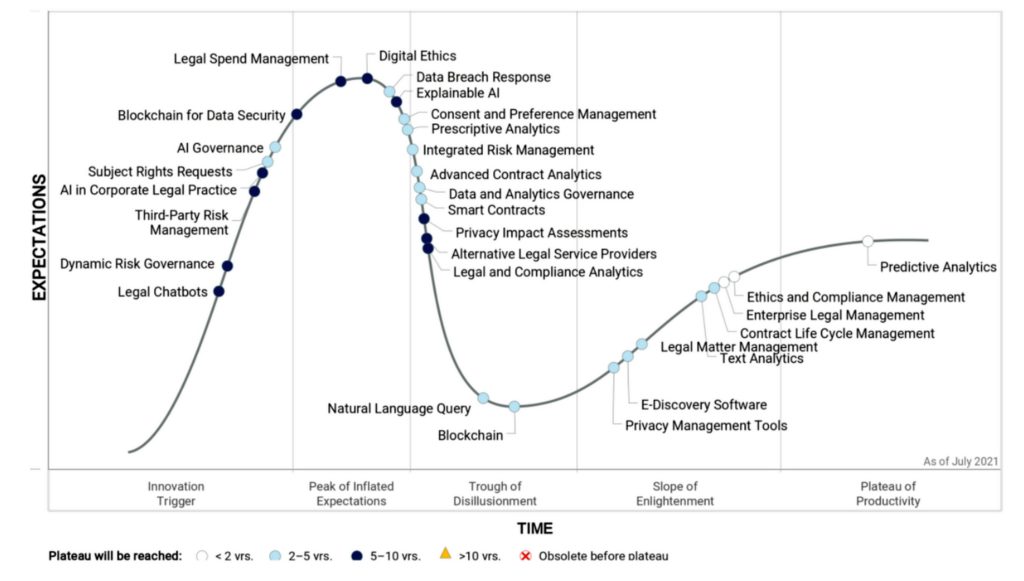As legal and compliance teams have faced acute pressures since the global pandemic and are struggling to manage their workload, legal leaders should focus their technology efforts in three areas to derive the maximum benefit.

Zack Hutto, director, advisory in the Gartner Legal & Compliance practice says technology adoption for the average legal and compliance team lags many other corporate functions, therefore legal must not try to run before it can walk.
He added that teams should first establish foundational systems of record and then invest in solutions to facilitate key workflows before exploring more sophisticated opportunities like digitally-enabled risk management.
The Gartner Hype Cycle for Legal and Compliance Technologies, 2021, covers a wide variety of innovations, including applications, platforms, concepts, methods and disciplines that will influence the roles and priorities of corporate legal and compliance leaders over the next decade. These innovations can potentially impact several different stakeholders.
The acute workload pressures brought about by the pandemic have made technology solutions appear more attractive than ever for over-burdened legal and compliance teams, according to Hutto.
“Compounding this, the market has seen ongoing consolidation even as new entrants continue to arise. Significant hype tends to follow more sophisticated technology innovation – like AI – as well,” he opined. “As a result, many legal leaders get overwhelmed by technology opportunities. Legal and compliance teams don’t always know what they want (or what they could pursue), but they know they need technology.”
Low digital maturity among legal departments
Gartner research identifies three critical opportunities for legal leaders looking to pursue technology: 1) establishing (or strengthening) foundational systems of record; 2) enabling core workflows with digital investments (beyond sending emails or excel spreadsheets); and 3) transitioning largely analogue risk management methodologies into the digital realm.
A range of mature technologies is available in the market to facilitate these areas.
Figure 1. Hype Cycle for Legal and Compliance Technologies, 2021

Hutto added that while the right technology for a given team depends on their underlying priorities, their digital progress to date, and their own risk posture, legal leaders must also monitor advancements in innovation to guide where they focus their technology investment.
“Focused investment in these areas can unlock the kind of transformational efficiency gains in legal and compliance like we have witnessed in other business functions, such as finance or HR,” he continued.
Foundational systems of record
The pandemic has driven a proliferation of legal and compliance work even as teams face disruption to their working environments. At the same time, the organizations they support face heightened demands for corporate accountability and transparency.
All the while, sophisticated innovations like analytics and AI promise to fundamentally change the practice and business of law, despite perennially remaining 5-10 years away.
Investments in the foundational system(s) of record for legal and compliance promise to address all three trends, enabling better capture and reuse of work product, reducing the otherwise ad hoc data capture required for ESG reporting, and building datasets that could unlock the potential of analytics and AI.
On the hype cycle for legal and compliance technologies there are several related technologies on or near the plateau that can help create such a system of record that will benefit directly from one.
Hutto believed enterprise legal management (ELM) systems continue to advance and provide a compelling option for pulling basic information out of poor-fit channels like email, personal devices or shared drives.
“Even more important than putting them in place is keeping a team on the same page for how the solution should be used. Only then can they enable more effective information sharing for the post-pandemic era of hybrid work, improve accountability and transparency in the legal organization, and enable predictive analytics capabilities,” he continued.
Digitally enabled workflows
“Legal and compliance teams face more work to manage than ever before, and the traditional overhead costs are enormous,” said Hutto. “Digitizing the highest volume workflows is both feasible, with mature technologies to do so, and has been shown to have profound results in terms of legal productivity for early adopters – if well managed”
Legal leaders should identify the workloads that are sapping the most time in their departments and target those as a priority. In many organizations, the processes of contract lifecycle management (CLM) are both time-consuming and ready for digitization with mature technology to do so.
Subject rights requests are another area that can be transformed with technology adoption and currently drain a lot of resources from many legal organizations.
“Leaders should carefully consider where and how to invest in a given workflow – for instance, a CLM solution with a basic intake method and user-driven workflow routing often delivers greater, more consistent value than an overly complex configuration with poor-fit automation that fails to get off the ground,” said Hutto, adding, “Don’t waste the precious time of your team – on top of the cap-ex on a tech solution – trying to tackle the wrong opportunities.”
Digital management of risk
Regulatory volatility, digital business transformation, increasing cyber risks, and the magnitude of information derived from monitored risk and security activities are straining the ability of organizations to manage risk effectively through traditional ‘analogue’ means, and the pandemic has only exacerbated this stress.
Hutto cautioned that trying to manage the organization’s risk profile without digital investments is not only needlessly time-consuming but also inadequate.
“Digital management of risk can help connect disparate processes or stakeholders, deliver unprecedented insight, and will underpin dynamic risk governance – a transformational shift for how organizations should approach risk governance,” he continued.
Legal and compliance leaders should look for opportunities to streamline and simplify their risk management and compliance-related activities and improve their understanding of risks through system integration with operational-level data sources, supported by risk program maturity assessment and consulting engagements, as well as augmentation of risk expertise and content through managed services.
But companies should approach the replacement of multiple risk management solutions with a single, integrated risk management solution carefully.
While such a strategy should reduce overall spending and improve risk mitigation in theory, organizations face immense complexity harmonizing disparate systems and processes and typically must sacrifice some best-fit tooling or workflows enjoyed by individual stakeholder groups.





